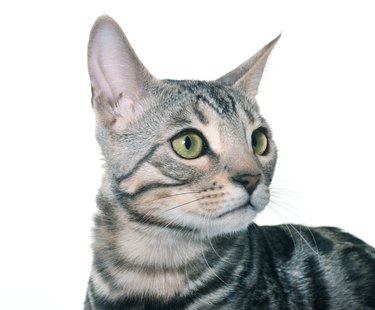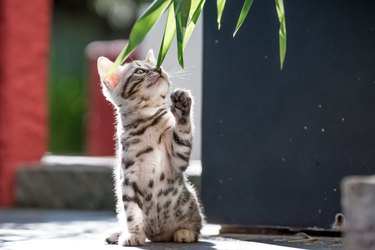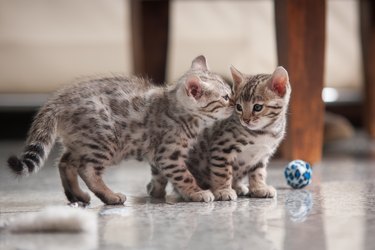
Silver Bengal quick facts
Length: 16 - 22 inches
Weight: Females: 6 - 12 pounds, Males: 9 - 15 pounds
Video of the Day
Video of the Day
Lifespan: 12 - 20 years
Coat length: Short
Coloring: Silver with a spotted, marble, or tabby coat pattern
Grooming needs: Low
Friendliness: Breed alone is not an accurate predictor of individual cats' personalities. However, Silver Bengal cats are generally regarded as playful and intelligent
The Bengal cat breed is one of the most recognizable breeds as they often look like wild cats. A brown Bengal cat with a rosette or marble pattern is often what comes to mind when thinking of the breed, but Bengal cats come in a variety of colors, including silver. Silver Bengals may not be their own breed, but they are a treasure if you are able to find a breeder with silver Bengal kittens available.
Bengals are a playful and active breed and the silver Bengal is no exception. Carefully consider the cat's personality and care requirements to make sure they will be a good fit for your family and lifestyle.

Silver Bengal cat history
Jean Mill started the Bengal breed as a cross between a domestic cat and a wild Asian leopard cat. Her goal was to obtain the looks of the wild cat while retaining much of the personality of a house cat. The original hybrid cats were used as a foundation for the Bengal breed of cats. Today's Bengals are easily recognizable as they have the striking appearance of a wild cat. Though the breed is fully domestic and no longer crossed with wild cats.
The silver Bengal is not a separate breed. Rather, it is one of the Bengal cat colors. The silver gene does not create a silver or grey color but it prevents the development of color pigment. This is located at the base of the fur which is white in color. The silver color came from outcrosses to Egyptian Mau cats and was furthered by outcrosses to American shorthair cats.
The Cat Fanciers' Association (CFA) Bengal breed standard recognizes several silver coat colors and patterns including:
- black silver tabby with any eye color except for blue
- blue silver lynx point with blue eyes
- blue silver mink tabby with aqua eyes
- silver seal lynx point with blue eyes
- seal silver mink tabby with aqua eyes
- seal silver sepia tabby with gold to green eyes
Silver snows may be silver lynx, silver mink, or silver sepia in color. The snows have black tail tips rather than brown. You may also encounter a silver smoke color. These cats have the silver gene which makes the base of the fur white or silver. The outer part of the fur is melanistic, or jet black. The International Cat Association (TICA) also recognizes several silver coat colors and patterns.
Silver Bengal cat personality
Bengal cats are an active and intelligent breed. They love to climb, leap, and explore. If you don't see the Bengal at first glance around the room, try looking up. The cats love to perch from high locations such as from the top of bookshelves. Bengals are a cat breed that loves water and they may be drawn to the running faucet in your kitchen or bathroom.
Regular playtime is important to help the cats burn off excess energy and keep them mentally and emotionally happy. These cats prefer company and can get bored when they are left alone for too long. They do well with other cats or dogs.
You can also train this intelligent breed to walk on a leash or play fetch. They respond well to positive reinforcement and clicker training. The cats can be quite affectionate as well, particularly at nap time when they may seem to transform into lap cats.

Silver Bengal cat lifespan and health issues
A healthy silver Bengal cat can live well into their teens and may even reach 20 years of age. There are a few genetic health problems that may affect some cats. These include:
- hypertrophic cardiomyopathy: a type of heart disease that causes part of the heart wall to thicken
- progressive retinal atrophy: a condition that can eventually lead to blindness
- pyruvate kinase deficiency: a condition that can cause the red blood cells to die
Reputable breeders will conduct genetic testing on their cats and stop breeding any cat that carries a genetic health condition.
Silver Bengal cat grooming and care
Bengal cats are not hypoallergenic, but they have short coats and don't shed much, which makes them a bit less likely to trigger allergies. The breed requires only minimal grooming. Simply brush the cat occasionally to remove any loose fur.
As with most breeds, they do shed their winter coat in the spring, so it is a good idea to brush them more frequently during that time. Also, be sure to check and trim the cat's nails, clean their ears, and brush their teeth with a pet toothpaste that is veterinarian approved.
The cats need a high-quality, high-protein diet to stay healthy. In fact, some cats may suffer symptoms of intestinal bowel disease and even be misdiagnosed with the condition. In many cases, parasite treatment and a change to a high-protein cat food can resolve symptoms. Always consult your veterinarian if you notice any signs of illness so you can get a proper diagnosis and treatment.

Welcoming a new cat into your home
Before bringing home a new silver Bengal kitten, make sure you cat-proof the home first. Remember these curious cats love to climb and explore, so don't neglect cat-proofing shelves and other nooks and crannies.
Set up a safe room where you can welcome your new cat. Make sure it has everything your cat may need including:
- food and water
- litter box
- cat tree
- cat toys
When your cat arrives, allow them to explore the room at their own pace. Bengals tend to prefer company, so spend plenty of time with the cat, but don't push them to do anything that makes them uncomfortable. Instead, be patient, offer to play, and give plenty of positive reinforcement.
If you have other pets, this is a good time to make introductions. Once your new cat is comfortable, you can open the door and allow them access to more of the house. Before you know it, your new Bengal will be an active member of the family enjoying every part of your home.